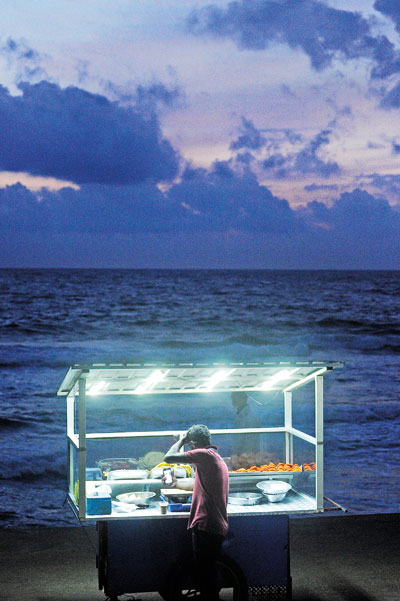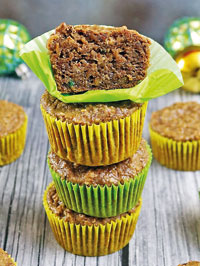That taste of home
View(s):There is an intricate bond between memory and food, finds out Adilah Ismail

Spice and sunset: A food cart with typical local delicacies at Galle Face Green
Last year, food blogger, recipe developer and graphic designer Shashi Charles took on the task of making Sri Lankan Christmas cake – a food she closely associated with her father who passed away in 2014 and who loved eating and making the cake. In a blog post detailing her memories with Christmas cake and her father, she writes of how her parents would painstakingly hand-cut dried fruits, candied fruits, fruit preserves and nuts, mixing, fermenting and then finally baking the heady concoction. The recipe was retired after his death but last year she dusted it out and made the Christmas cake in honour of her father – a bittersweet, nostalgic experience which she recounts in her blog http://runninsrilankan.com/.
Currently based in Atlanta, Georgia, USA, she adapted the recipe to fit the ingredients on hand. Ingredients like chow chow, pumpkin preserve, golden syrup and semolina were substituted with pecans, spelt flour, molasses and maple syrup; the traditional cake pieces, served as Christmas cupcakes.
Having lived away from Sri Lanka since 1984, Sri Lankan Christmas cake is not the only Lankan food which carries memories for her. One of her fondest food memories are the ‘apple cakes’ her father would bring from a local bakery, when she was a child. “They were not made with apple at all, just leftover cakes and some sort of binding agent pressed together to look like an apple and they were decorated with an icing that resembled apple skin. I haven’t ever had cake like that anywhere and I wish I could find a place online that sold them as I haven’t been able to recreate them at all,” says Shashi via email to the Sunday Times.
Food and memory are almost always inextricably linked. Anita Mannur in Culinary Nostalgia: Authenticity, Nationalism, and Diaspora explores the process of viewing one’s homeland through culinary memories and linking identity with nostalgically-framed food narratives. As a result, she writes, food is cast into a web of affiliations and becomes a symbol of ethnicity, serving “both as a placeholder for marking cultural distinctiveness and as a palliative for dislocation.”
Diasporic food narratives differ according to personal associations (both negative and positive) with different foods. A dish that may spark fond rose-tinted recollections for one person may not have the same effect on another.
Kumar Pereira of MasterChef Australia fame grew up in a house filled with great eastern and western food, parents who entertained frequently and a mother with a flair for creative cooking. The cooking that abounded during family weddings was particularly memorable and his childhood was tinged with food memories and exposure to different cuisines. When Kumar returns to Sri Lanka, his food search encompasses items that he would be unable to find overseas: “innala, bathala, boiled manioc and sambol, really good kitul treacle, the wonderfully smoky and sweet mangoes, the small sweet and slightly sour bananas -ash plantains, all simple pleasures but that bring back memories”.

Christmas cake reinvented as cupcakes by Shashi Charles
Of course, the food cultures and culinary zeitgeist which prevailed in Sri Lanka during his childhood was markedly different. Foods and eateries that were popular and the dishes consumed daily were influenced by the socio-economic climate that pervaded during the time. “As a child growing up in the fifties and sixties and during an era where there were import restrictions it made people improvise and be creative, sometime with awful results! I remember someone making ‘mock strawberry jam’ with white pumpkin sugar (puhul) and food colouring! On the positive side it made people appreciate local fruit and vegetables and my mum would make a wonderful mango mousse, avocado mousse, passion fruit and one made with beli,’ writes Kumar in an email to the Sunday Times.
“There were places that we loved going to: Green Cabin, Pilawoos, Buhari Hotel and a place in Bambalapitiya that did dosai – I think it was called Greenlands. As for trending foods at the time – it was the usual fish or meat cutlets, angels on horseback, stuffed prunes or dates, Chinese rolls, patties and ribbon sandwiches and a little cashew nut pastry which was called ‘cheesecake’ and has no resemblance in taste or texture to what we now know as cheesecake – I find that nothing has changed!”
When living away, are there specific foods which conjure up Sri Lanka and serve as sensory cues? “All the spices bring me back to the island, capsicum, chilies in particular, but also ambarella chutney, treacle, avocado eaten as a fruit with brown sugar….pittu, of course, string hoppers, biriyani,” says poet and writer Indran Amirthanayagam. Currently based in Port au Prince, Haiti, Indran is the author of Uncivil War and also writes poetry and essays in English, Spanish, French and Portuguese. Migrating when he was eight and a half, Indran’s link with the island remains strong and spills into his writing. “As a kid Elephant House ice cream was important. Now I would go back rather for the thosai kaddais, the roti shops, and thambili on the roadside setting off on a journey along the coast, to the beaches, to Yala.Ah I must not forget the mangosteen, favourite fruit of my youth, and the rambutan, the kolikutu plantain, and kool, that cool fish soup of the North.”
“I crave whole spices crushed, ground to make pungent, fresh powders available to flavour meat or fish or fowl….and would travel more than a thousand miles for a seasoned and multitudinous lamprais,” he writes. “The same goes for string hoppers and sothey and poll sambol in Green Cabin. Or some vaddai from a hawker on Galle Face Green. Thosai and seer fish would be high on my list. There is no more magnetic phrase for me than thosai kaddai.”
For Safra Rahman, a Sri Lankan expat residing in West Asia, the smell of kidu rice (rice and curry, wrapped in a woven coconut lead basket), chicken fry, tempering of rasam and the smell of desiccated coconut are olfactory triggers which open a floodgate of memories of home and Sri Lanka.From her mother’s muscat (a sweet she would make with her mother before Eid), palaharam, kavum, kokis, matchstick pastries from Royal Bakery, Battenberg cake from Perera and Sons, Chocolate cake, cream buns and Pineapple upside down cake from Green Cabin, lamprais and Bombai Muttai – the foods Safra yearns for when abroad are closely tied with personal events or people.
Having lived in West Asia for 23 years, there are specific Colombo food pilgrimages that provide the perfect epilogue to her annual visits to Sri Lanka. “I will not board the flight until faluda is tasted at the Bombay Sweet House in Wellawatte. And prawn vadai from Galle Face is mandatory,” she affirms.
A few months ago, I went to say goodbye to a friend who was migrating. We surveyed the half-full suitcase and the items piled on the floor of her bedroom with some trepidation. Our task for the evening was not an easy one. Her flight was the next day. She had limited luggage allowance and seemingly unlimited food items to pack. In a corner of the room I recognized a fried snack we used to consume almost every day at the school canteen, one that I hadn’t seen in years. An unhealthy union of deep fried dough, oil, salt and chilli powder which dulled one’s sense of taste with each mouthful; it was cheap but spicy and filling, easily suiting a hungry schoolgirl pocket and palate.
Dodol, manioc chips, fried jakfruit chips coated in sugar syrup, homemade chilli paste, love cake, jaggery cake, Malay pickle, Tipi Tip and slabs of jaggery were laid on the floor. Meanwhile, homemade patties, cashew nuts dusted with chilli powder and a delectable homemade chocolate cake also had to be fitted into her luggage.
Having grown up in Sri Lanka and now moving countries, her acclimatization to a new land – like many before her – was being eased with well-loved and familiar tastes. We settled down to pick out which food item or culinary memorabilia should accompany her on her new life abroad. Clothes, shoes and medicines lay forgotten and deemed unessential for the moment. We had bigger, slightly more delicious decisions on hand.


